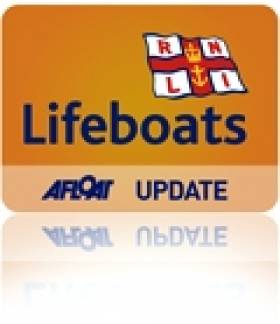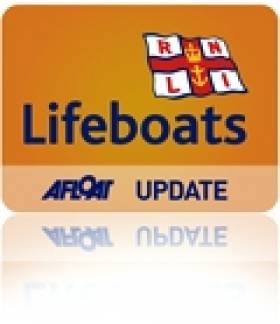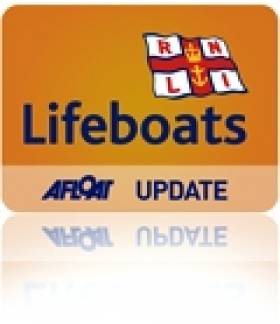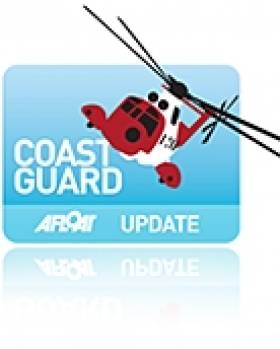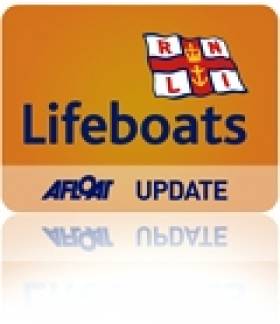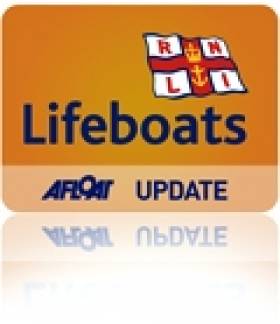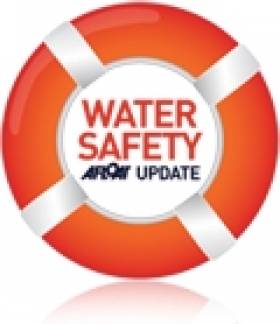Displaying items by tag: Rescue
Stranded Students Rescued From Island By Galway RNLI
#RNLI - Galway RNLI came to the rescue of three students who got stranded on Hare Island yesterday afternoon (Monday 13 May) after getting caught in the tide off Ballyloughane Beach.
The two young women and young man, in their late teens/early 20s, had gone for a walk and were spotted waving from the island by a local resident who contacted the emergency services and Galway RNLI.
Conditions at the time (around 4pm) were changeable with heavy showers.
Three volunteer members of the inshore lifeboat crew were working in the vicinity of the station at the time and launched the boat in six minutes.
The three students were picked up safely and brought back to the lifeboat station at Galway Docks where they were warmed up and given tea. They did not require medical attention.
The lifeboat crew on this callout were helm David Oliver, Dara Oliver, David Badger and Olivia Byrne.
Lifeboat shore crew John Bryne said: "The three students did the right thing waiting on the island and not attempting to get off."
It's not the first time that people have been stranded by the incoming tide on Hare Island, as Galway RNLI were called to a similar incident in September 2010.
#RNLI - Dun Laoghaire RNLI was involved in the recovery yesterday afternoon of a sinking boat following the rescue of three people after the vessel began to sink off the Wicklow coast.
Three people were pulled from the water when their small boat got into difficulty off Bray on Sunday 12 May.
A local boat responded to the Mayday alert and brought the casualties to safety.
The RNLI lifeboat from Dun Laoghaire and the Greystones Coast Guard boat took the boat that was almost fully submersed under tow to shore.
Winds gusted to storm force towards the end of the operation but conditions were otherwise fresh, with only choppy waves off the coast.
The incident occurred shortly after midday when the 15ft speedboat was almost one mile from Bray Harbour.
Koda The Husky Rescued By Quick-Thinking RNLI Crew
#RNLI - Two volunteer crew members from Kinsale RNLI came to the rescue of a husky dog who had a dramatic fall off a cliff near the Co Cork village recently.
Koda, a pedigree husky, was inspecting the coastline around Sandycove when she got too close to the edge and slipped over the 30ft cliff.
The dog landed in water with a strong current that swept her out to sea despite her desperate struggles to reach the shore. She managed to get herself back on a ledge by which time the alarm was raised and volunteer lifeboat crew were on their way.
A jagged reef also meant that Kinsale RNLI’s inshore lifeboat couldn't get close enough to help drag the struggling dog from the water.
However, Kinsale RNLI volunteers Nick Searls and Ian Fitzgerald were at the scene within minutes, and realised the danger facing the terrified dog.
Searles dived into the sea and swam over 60 metres to reach the animal. He managed to attach a harness and was able to swim slowly back to shore, dragging the weakened Koda with him. He was then assisted by safety line out of the sea by Fitzgerald.
Koda was immediately taken to a Kinsale vet, who confirmed that despite being exhausted and shocked by her ordeal, the dog was none the worse for wear.
In other news, Donaghadee RNLI assisted two men on board a yacht which got into difficulty off the Co Down coast yesterday morning (Tuesday 7 May).
The volunteer lifeboat crew was requested to launch at 9.50am by Bangor Coastguard to go to the aid of a yacht which had ran aground.
The 30ft yacht with two people on board had gone aground on rocks at the entrance to Donaghadee Marina.
With the help of another vessel, the lifeboat crew was quickly able to get a tow line to the yacht and pull it off the rocks.
The yacht, which had sustained some damage to its rudder, was able to make its way safely into the marina.
Kerry Calls Emergency Workers For 'Heroes Week' This June
#Rescue - Emergency workers with Irish heritage from all over the world are being invited to celebrate Heroes Week in Tralee this June.
As part of The Gathering 2013 initiative, the chiefs of Co Kerry's emergency services will welcome first responders with Irish heritage - or an affinity for Ireland - for a week-long reunion among colleagues in Ireland.
That means any members of the police, fire service, coastguard, ambulance service, the Red Cross and the RNLI the world over!
Visitors will be declared 'guests of honour' in Tralee for the week, and among the various events planned between 12-17 June, they will have a chance to trace their Irish roots, and sightsee around one of Ireland's most picturesque spots.
And what's more, the not-for-profit event aims to raise funds for vital local rescue and lifesaving services.
As reported on Irish Central, Mayor of Kerry Terry O'Brien said: “We salute the men and women who go to work each day with only one purpose in mind – to protect and save lives. Many of them have Irish roots and we want to invite them home.
"Kerry has a strong tradition of volunteerism and a collective pride-of-place that will see us roll-out the red carpet to welcome our Heroes home to the Kingdom County. I hope you can join us and we assure you of a memorable visit with us and a warm Irish welcome.”
Full details of the event, including booking information, are available on the Heroes Week website HERE.
Sligo Bay RNLI Readies To Give It Some Welly This Mayday
#RNLIMayDay - Sligo Bay RNLI in Rosses Point is counting down this week to Mayday, the charity’s annual national fundraising campaign in Ireland.
Now in its second year and running nationwide, from this Wednesday 1 to Bank Holiday Monday 6 May the RNLI is asking the public to 'give it some welly' and help its volunteers to continue to save lives at sea.
Encouraging the people of Sligo to support their local lifeboat station this week is one man who experienced first-hand the lifesaving work of the RNLI volunteers based in Rosses Point, when he was rescued in 2011.
"I guess it is always nice to know the orange boat will be coming up the bay looking for you if you get into difficulty," he said, "so remember to call as soon as you know you are in trouble."
With a fun theme in mind, the Mayday appeal is calling on people to lend their support by either purchasing a special RNLI Mayday yellow welly key ring which will be on sale for €2 in various schools in Sligo during the campaign, or by organising their own yellow welly fundraising event.
The yellow welly is an essential piece of the RNLI volunteer lifeboat crew member’s kit. Waterproof with steel-capped toes, the specially designed boots keep the volunteer crew’s feet warm and dry while also protecting them in dangerous conditions on deck.
During gale force winds, rain and ice, keeping a sure footing can literally mean the difference between life and death for volunteers. A pair of yellow wellies for crew members costs €50.
The public can also join in the social media campaign and help the RNLI raise awareness of its lifesaving work this Mayday.
All you have to do is take a photo of yourself holding an RNLI Mayday yellow welly key ring and tweet the phrase ‘I am giving it some welly for the RNLI this Mayday’ including the hashtag #RNLIMAYDAY and mentioning @RNLI.
For more information on how you can get involved or where you can purchase a key ring, log on to rnli.org/mayday
Howth Coast Guard Trains With Irish Red Cross
#Coastguard - Howth Coast Guard has blogged about its recent medical exercise with the Irish Red Cross.
The multi-casualty medical training exercise involved lowering a number of qualified and trainee emergency medical technicians (EMTs) into Whitewater Brook by the heights rescue team.
These EMTs served as serious trauma victims who were then retrieved through the joint effort of over 40 personnel between the two organisations who worked together to triage, treat and evacuate.
Another recent training exercise, as featured in the video above, involved the safe evacuation of a casualty with a lower limb fracture.
"One of the more common callouts we receive are for people enjoying walking or running in the area who slip and fracture a lower limb or ankle injury," said the North Dublin-based unit of the Irish Coast Guard.
"The team regularly train for this scenario, ensuring all members are able to stabilise, package, and evacuate by stretcher a casualty in this situation."
RNLI Crews Assist Windsurfer, Stricken Fishing Boat in Co Down
#RNLI - Portaferry RNLI rescued a windsurfer who got into difficulty off the Co Down coast yesterday (16 April).
The volunteer crew launched their inshore lifeboat before 5pm yesterday evening to go the aid of the injured windsurfer reported to be in the area of Pig Island, a small island in Strangford Lough close to Newtownards Sailing Club.
The weather at the time was described as blowing slight to moderate winds with good visibility.
The crew was on scene at 5.15pm where they found the man on Pig Island accompanied by two other men. The windsurfer, who was suffering from a shoulder injury, was transferred to the lifeboat and made comfortable before being taken to the sailing club, where he was then transferred into the care of the coastguard and passed to the ambulance service to be taken to hospital.
Speaking after the rescue, Portaferry RNLI lifeboat operations manager Brian Bailie said: "As the charity that saves lives at sea, we will always respond to any call for help where someone is in danger.
"Strangford Lough is a popular destination for a wide range of water sport enthusiasts and it is important that they take all necessary precautions when using the lough.
"As we are all aware, accidents can and do happen and it is at such times that the work carried out by the volunteer crews of the RNLI is so important."
Elsewhere in Co Down yesterday, Bangor and Donaghadee RNLI assisted a fisherman whose 28ft commercial fishing boat experienced engine failure.
The crew quickly located the disabled boat one mile west of the Copeland Islands at the mouth of Belfast Lough yesterday morning after 11.15am.
With the vessel drifting closer to the island shores and the wind gusting gale force eight, a tow line was quickly rigged and passed to the fishing boat. Bangor RNLI was escorted by Donaghadee RNLI's all-weather lifeboat as it towed the fishing vessel to the safety of Bangor Harbour.
Bangor RNLI volunteer helm Peter Scott, who was involved in this rescue, said: "Engine failure close to shore could lead to a life threatening situation. We always urge everyone going to sea to make sure their electrical systems and engine are well maintained and in good working order. A good anchor and chain should always be carried as part of essential safety equipment.
"We are glad the skipper of this vessel is now safely ashore," he added.
Lifeboat Roundup: Windsurfers Rescued In Waterford; Boats Aground in Wexford, Lough Erne
#RNLI - The Dunmore East RNLI lifeboat was tasked yesterday (7 April) to assist two windsurfers in difficulty near Duncannon in Waterford Harbour.
In rough conditions yesterday afternoon, with south-east winds force 6/7 blowing, coxswain Pauly Daniels reached the casualties' position within 30 minutes.
By this stage one of the surfers had made it ashore safely at Duncannon. The Dunmore East lifeboat quickly located the other windsurfer a quarter of a mile north of Duncannon. The casualty was safely recovered from the water and landed ashore nearby.
Neither casualty was injured and did not need medical attention.
Nearby in Wexford, five teenagers were rescued from a small speedboat after it suffered engine failure and ran aground on the River Slaney around 1.20pm yesterday.
According to Lorraine Galvin, volunteer press officer at Wexford RNLI, the teens' "fast call for help to the coastguard greatly helped in ensuring their speedy rescue in cold, rough weather conditions".
At the time of the rescue there were wind speeds of force 5 south-easterly and a rough sea state. All of the passengers were starting to suffer from the cold and were treated for mild hypothermia.
Meanwhile, on Upper Lough Erne last Friday the volunteer lifeboat at Enniskillen RNLI (Carrybridge) launched to reports of a vessel that had run aground.
The RNLI lifeboat and rescue water craft were both launched and proceeded to the casualty's last known location 2.5 miles upstream from Carrybridge at Innishmore viaduct.
On route to the scene at the Innishmore viaduct, the volunteer crew got further information that the vessel had managed to refloat and was currently at Killygowan Island.
A full inspection was carried out and none of the crew on the casualty vessel were found to be in need of medical attention.
It was decided with the owner's permission that the volunteer crew would escort their vessel back to Carrybridge with the lifeboat leading and rescue water craft following as the navigation lights were not working.
Busy Days For RNLI Lifeboats In Co Down
#RNLI - Newcastle RNLI’s always-on-call lifeboat crew had to abandon their buckets and sponges during a fundraising car wash at the weekend to respond to an emergency at the Co Down town’s harbour.
The RNLI volunteers were busily soaping and rinsing cars for their annual Easter fundraiser on Saturday when they were alerted to a woman in trouble in the freezing water a few yards from one of the piers.
The car wash was immediately abandoned and within minutes the inshore lifeboat Aldergrove II was launched and rushed to the woman’s aid.
At the same time, crew member Shane Rice grabbed a lifebelt from the pier and jumped into the water to assist the woman. He kept her afloat while the Aldergrove II came alongside.
The woman was helped into the rescue inflatable, wrapped in blankets to prevent hypothermia, and taken back to shore where an ambulance was waiting to take her to hospital.
Newcastle RNLI’s deputy launching authority Clifford Moorehead said afterwards: "The lifeboat crew are always ready to respond in an instant to any emergency. It is fortunate that the car wash was in progress at the time and the crew members were on hand to swiftly deal with this case.
"After the rescue the crew members came back to the harbour and resumed their car wash. It’s just all in a day’s work for the RNLI."
It wasn't the only callout of the weekend for the RNLI in Co Down, as Bangor RNLI assisted a lone sailor who got into difficulty on a sailing dinghy Easter Sunday.
At 1.10pm the volunteer lifeboat crew received an urgent request from Belfast Coastguard to launch the lifeboat and rescue one person from a 17ft dinghy.
The sailing dinghy had reportedly gone aground on ‘Cockle Island’ off Groomsport Harbour on the southern shores of Belfast Lough.
Upon arrival at the scene, the volunteer crew found that the occupant onboard the dinghy had been assisted by another boat owner and the vessel had been safely tied to a mooring buoy.
Meanwhile, last Wednesday evening Portaferry RNLI was launched to reports that red flares has been sighted on Strangford Lough off Kircubbin in Co Down.
They were joined by a coastguard team that searched the shoreline and after some time recovered a spent flare casing. The inshore lifeboat and its volunteer crew were stood down after a number of hours with the callout proving to be a false alarm.
Portaferry RNLI lifeboat operations manager Brian Bailie said: "A member of the public acted in good faith ... alerting the emergency services to what they understood to be a distress flare on the lough."
He reiterated that flares "should only be used in emergency situations".
NI Lifeguards To Feature In New TV Series
#WaterSafety - RNLI lifeguards in Northern Ireland are to feature on a new television series on UTV.
The Magazine starts on Sunday 7 April at 7.30pm with host Sarah Travers in her home town of Portstewart to introduce viewers to some of her favourite people, places and topics.
As part of the first programme, TV presenter Emma-Rosa Dias will find out what it takes to be a lifeguard with the RNLI when she visits the charity’s area support centre in Ballymoney - before being put through her paces by RNLI lifeguard supervisor Tim Doran to see if she is ready for the challenge.
After a test in the swimming pool, Dias experiences a slice of the real thing when she pays a visit to Portrush East Strand on the Causeway Coast, one of the five beaches in Northern Ireland which begins its Easter season on Good Friday tomorrow 29 March.
As previously reported on Afloat.ie, this lifeguard cover will run throughout Easter week until Sunday 7 April.
Filming took place on Monday afternoon and despite the unseasonal weather, the charity’s highly trained lifeguards took the opportunity to demonstrate that they will be ready to assist the visitors who will brave the elements and take a trip to the seaside over the Easter break.
Speaking following the afternoon’s shoot, Tim Doran said filming with UTV was a great way to show how highly trained RNLI lifeguards are.
"Our lifeguards spot potential dangers before they develop, and are on hand to give appropriate safety advice and respond immediately if anyone gets into difficulty," he said. "Because our lifeguards work closely alongside our volunteer lifeboat crews, it means the RNLI offers beach-goers and water-users a seamless rescue service from beach to open sea."
While Easter is often the time when people are getting back in the water after the winter, and while it’s good to see people enjoying the beaches, the RNLI is encouraging visitors to make sure they have the right kit to keep warm.
"It’s much colder now then it was this time last year," Doran added, "and our lifeguards will be wrapping up and we’d encourage everyone else to do the same. So, if you are heading into the sea, make sure you’re wearing a good wetsuit or drysuit, go with other people and keep an eye on each other.
"Keeping warm in cold weather can take a lot of energy, so fatigue can be an issue, plus watch out for the wind chill factor – even a slight breeze can have a dramatic effect on how cold it feels."
Meanwhile, to find out how Emma-Rosa Dias gets on, tune into UTV at 7.30pm on Sunday 7 April.





























